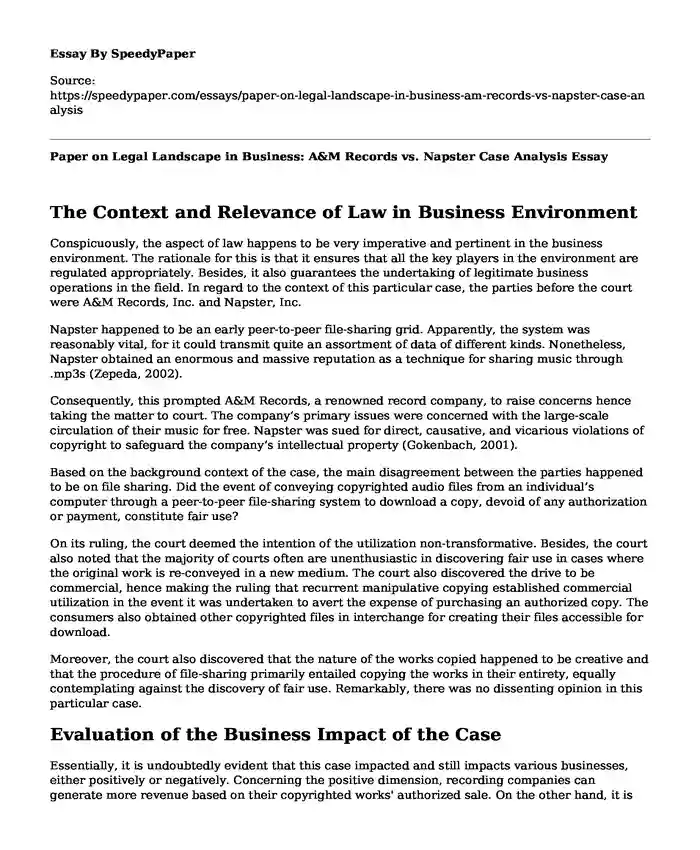
| Essay type: | Analytical essays |
| Categories: | Marketing War Disorder Historical events & places |
| Pages: | 3 |
| Wordcount: | 758 words |
The Context and Relevance of Law in Business Environment
Conspicuously, the aspect of law happens to be very imperative and pertinent in the business environment. The rationale for this is that it ensures that all the key players in the environment are regulated appropriately. Besides, it also guarantees the undertaking of legitimate business operations in the field. In regard to the context of this particular case, the parties before the court were A&M Records, Inc. and Napster, Inc.
Napster happened to be an early peer-to-peer file-sharing grid. Apparently, the system was reasonably vital, for it could transmit quite an assortment of data of different kinds. Nonetheless, Napster obtained an enormous and massive reputation as a technique for sharing music through .mp3s (Zepeda, 2002).
Consequently, this prompted A&M Records, a renowned record company, to raise concerns hence taking the matter to court. The company’s primary issues were concerned with the large-scale circulation of their music for free. Napster was sued for direct, causative, and vicarious violations of copyright to safeguard the company’s intellectual property (Gokenbach, 2001).
Based on the background context of the case, the main disagreement between the parties happened to be on file sharing. Did the event of conveying copyrighted audio files from an individual’s computer through a peer-to-peer file-sharing system to download a copy, devoid of any authorization or payment, constitute fair use?
On its ruling, the court deemed the intention of the utilization non-transformative. Besides, the court also noted that the majority of courts often are unenthusiastic in discovering fair use in cases where the original work is re-conveyed in a new medium. The court also discovered the drive to be commercial, hence making the ruling that recurrent manipulative copying established commercial utilization in the event it was undertaken to avert the expense of purchasing an authorized copy. The consumers also obtained other copyrighted files in interchange for creating their files accessible for download.
Moreover, the court also discovered that the nature of the works copied happened to be creative and that the procedure of file-sharing primarily entailed copying the works in their entirety, equally contemplating against the discovery of fair use. Remarkably, there was no dissenting opinion in this particular case.
Evaluation of the Business Impact of the Case
Essentially, it is undoubtedly evident that this case impacted and still impacts various businesses, either positively or negatively. Concerning the positive dimension, recording companies can generate more revenue based on their copyrighted works' authorized sale. On the other hand, it is quite detrimental to most file-sharing companies since the ruling deprives them of the aptitude to share personal copyrighted works; hence, they are unable to generate substantial revenue.
Amongst the organizations likely to face substantial implications prompted by this case is Sony Music Entertainment. Specifically, the primary rationale as to why I selected this organization is because it is a renowned recording company that usually deals with copyrighted works. Indeed, to no small extent, the case is envisioned to impact the organization positively. In precision, the positive implications of the case can be outlined as follows:
Firstly, the case demonstrates adequately that the possession of intellectual property by a company guarantees protection from other organizations from utilizing something identical in the creation of brands or commodities. Based on this, the adoption of the intellectual property law by Sony Music Entertainment will be imperative in safeguarding the recorded works. Apparently, devoid of this protection, the organization could incur more expenses in the defense against an individual or organization or even rebranding and consequently miss out on profitable prospects (Bently & Sherman, 2014).
Secondly, Sony Music Entertainment is likely to nurture innovation appropriately in the event; that it adopts the intellectual property protection law in its operations. Deprived of fortification of thoughts, the organization will not reap the full benefits of its discoveries and will emphasize exploration and improvement.
References
Bently, L., & Sherman, B. (2014). Intellectual property law. Oxford University Press, USA. https://books.google.com/books?hl=en&lr=&id=nmKCBAAAQBAJ&oi=fnd&pg=PP1&dq=intellectual+property+law&ots=ciJ7F4jIiw&sig=-KQAZ7d6xhNXCH2LRtMZtpp4zic
Gokenbach, J. (2001). A & M Records, Inc. v. Napster, Inc.: A Case Comment. Denv. UL Rev., 79, 259. https://heinonline.org/hol-cgi-bin/get_pdf.cgi?handle=hein.journals/denlr79§ion=17
Zepeda, L. M. (2002). A & M Records, Inc. v. Napster, Inc. Berkeley Tech. LJ, 17, 71. https://heinonline.org/hol-cgi-bin/get_pdf.cgi?handle=hein.journals/berktech17§ion=12
Cite this page
Paper on Legal Landscape in Business: A&M Records vs. Napster Case Analysis. (2023, Nov 16). Retrieved from https://speedypaper.com/essays/paper-on-legal-landscape-in-business-am-records-vs-napster-case-analysis
Request Removal
If you are the original author of this essay and no longer wish to have it published on the SpeedyPaper website, please click below to request its removal:
- My Severe Academic Anxiety, Essay Sample
- Battle of Britain - Free Essay in History
- First Person Narrative of a Person in World War One. Free Essay for Students.
- The New Deal for the United States
- Essay Sample: Effects of Depression in Adolescence and the Prevention
- Research Paper on Cognitive Behavioral Therapy As an Effective Treatment for Anxiety in a School Setting
- Paper Example. An Assessment of Google V China Case
Popular categories




